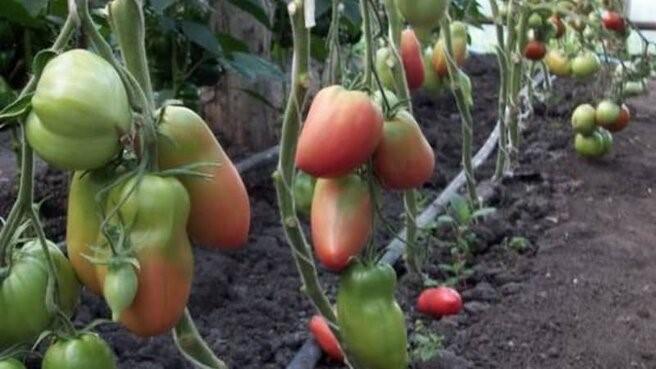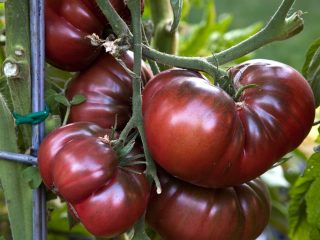Content
The Kapiya rosea tomato pleases gardeners with juicy and fleshy fruits. They especially note the excellent taste, which differs significantly from other varieties. The high quality of the crop and resistance to major diseases make the tomato popular for growing in greenhouses and open ground.

The positive characteristics of the tomato variety are evidenced by numerous reviews
History of selection
The authors of the Kapia Pink variety were specialists from the Research Institute for Breeding Vegetable Crops. Thanks to their efforts, a tomato with high yield potential and excellent taste characteristics was born.

A new type of pink-fruited tomato, Kapiya, successfully passed city tests and was approved for use in 2008
Description and characteristics of the tomato variety Kapiya pink
The Kapia rose variety is a tall, strong plant up to 2-2.3 m high.It has an indeterminate type of growth, which means that it is necessary to tie not only the entire length of the stems to the support, but also the brushes in which the fruits are set.
Tomatoes are medium-sized, weighing 150 g, but with proper care can reach 230 g. They are elongated and shaped like peppers, but with spouts. The skin is elastic, raspberry-pink in color. The pulp of tomatoes is fleshy and has few seeds.

Leaves are carved, elongated, intense green color
Maturation period
Pink capia is a mid-season variety. The period from the appearance of sprouts to the full ripening of tomatoes lasts about 117 days.
Tomato productivity Capia rosea
This tomato is a high-yielding one. With good care, gardeners get up to 5 kg of marketable tomatoes from one bush. Harvesting takes place in the second half of July.

If the rules of agricultural technology are observed, the plant bears fruit evenly until the end of the season.
Disease resistance
The Kapia rosea variety is naturally endowed with strong immunity and is therefore resistant to many nightshade diseases. But still, under unfavorable external conditions, the fungus can damage tomato bushes.
Growing regions
This type of tomato is highly adaptable to various growing conditions. Thanks to this, it has become widespread among residents of the northern and southern regions.
Purpose and application
Rosea capia is a universal tomato.The fruits are suitable for summer salads and homemade preparations. They can be dried, dried, frozen, and used for preparing any dishes.

Fresh tomatoes are good for slicing because, in addition to their expressive taste, they have a pleasant aroma
Advantages and disadvantages
The high quality of the harvest and keeping quality make the variety suitable for cultivation not only for personal purposes, but also for sale. Resistance to infections allows you to grow tomatoes without the use of chemicals.

The variety Kapija rosea is capable of forming ovaries in any weather conditions
Pros:
- good survival rate in all regions;
- productivity;
- ease of care;
- transportability over long distances;
- long-term storage.
Minuses:
- obligatory garter;
- regular stepsoning;
- bush formation.
Sowing seeds and planting in open ground
To begin with, the seed is treated with a solution of potassium permanganate, and then soaked in warm water and left for a couple of days. Seedling boxes are filled with loose substrate and depressions are formed into which the seeds are sown. They are sprinkled with a thin layer of substrate on top and covered with film. Containers with tomato seeds are placed on a light and warm windowsill.
When several small leaves appear on the seedlings, they are transplanted from a common box into separate pots, where they are kept until the onset of warm weather. At the end of spring or early summer, tomato seedlings are planted in open ground.
In the prepared area, holes are first formed, where a little ash and mineral fertilizers are placed. A layer of soil and expanded clay is poured on top and the surface is leveled. After this, a tomato seedling is installed, the roots of which are covered with earth.

The seedlings are watered abundantly so that they take root well and bring a rich harvest in the future.
Care instructions
When growing Kapia rosea tomatoes, special attention should be paid to lighting. Lack of light leads to the fact that the bushes stop growing, form a weak ovary, and the fruits become smaller and do not absorb sugar well. Therefore, before planting seedlings in open ground, you need to decide on the location. First of all, it should be dry and warm, and secondly, protected from strong winds.
Also, when planting, you need to remember that tomatoes prefer fertile, loose, slightly acidic soil. In addition, they do not tolerate excess moisture, which means you should avoid places where water accumulates and stagnates.
When growing tomatoes, it is important to follow the watering norm. Insufficiently moistened soil will cause flowers to fall off and reduce the size of fruits, while over-moistened soil will cause rotting of the roots and lead to the development of fungal diseases.
In addition, plants need to be fed periodically. Seedlings will benefit from nitrogen, but adult bushes need phosphorus-potassium fertilizers, since they have a good effect on the fruiting process and improve the taste of tomatoes, making them sweeter.
Treatment against diseases and pests
It is recommended to follow a schedule of preventive measures that will help maintain the health of the tomato crop at a high level.
Of the pests, the most common pests that plague Kapia rosea bushes are whiteflies and spider mites.

In the fight against insects, insecticidal preparations are used in accordance with the manufacturer’s instructions, for example, Actellik
Conclusion
The Kapija rosea tomato bears tasty and beautiful fruits. They are lightweight and transportable, for universal use. This variety is characterized by resistance to diseases; to maintain this quality, you need to remember the basic rules of crop care.
Reviews from gardeners about the tomato Kapija rosea








